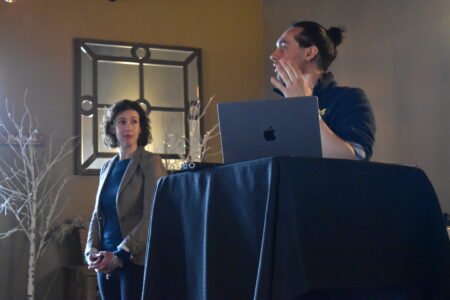WUPHD: COVID-19 showing community spread

Garrett Neese/Daily Mining Gazette A station at Walmart in Houghton offers face coverings to customers as they walk inside. The change was part of additional safety measures Walmart took to remind people of the importance of face-coverings, the company said. Walmart’s policy has been to encourage mask wearing, but not refuse service, spokesman Casey Staheli said in an interview prior to Gov. Gretchen Whitmer’s executive order mandating mask-wearing in businesses starting Monday. Staheli said Walmart employees at entrances have been trained in de-escalation techniques. At some stores, they have also used third-party resources for security.
HANCOCK — The latest COVID-19 cases in the area indicate community spread, the Western Upper Peninsula Health Department’s community and planning preparedness director said Thursday.
The WUPHD is currently tracking several clusters, Pete Baril said.
Since the start of July, the number of cases in Houghton County has risen from 11 to 24. In the early months of the epidemic, the cases were linked to travel, or exposure to someone who traveled, Baril said.
“The cases that we’re seeing now, we can’t necessarily pin it back to travel,” he said. “These cases are now leading to additional local cases.”
Friday, Gov. Gretchen Whitmer issued an executive order expanding mask requirements Friday. The order, which takes effect Monday, requires businesses open to the public to refuse service or entrance to people without masks, and also requires the use of masks in crowded outdoor spaces. A prior executive order already required people to wear masks in enclosed public settings.
Places of worship are exempt from the order.
Violations are considered misdemeanors and punishable by a $500 fine.
At a press conference Thursday, Whitmer said the state was looking at the need to strengthen compliance with mask-wearing, pointing to a rise in cases and recent viral videos of Fourth of July partiers downstate.
“We cannot let our guard down,” she said. “We cannot afford to play fast and loose with the rules. And just look at what’s happening with Florida. It took less than two weeks for Florida to go from 100,000 to 200,000 positive cases, and the cases there are still climbing.”
With the loosening of restrictions on gatherings, travel and business operations, people with COVID-19 are coming into contact with far more people, Baril said. The number of infections stemming from a single case has surged above one, the benchmark for whether a virus is spreading. In some cases, that number is above three.
Expanded socializing also makes contact tracing more difficult, Baril said. During the shutdown, it was usually possible to obtain a comprehensive list of where people had been and their contacts. For the first time, last week the WUPHD released a list of places people recently diagnosed with the virus had visited. With so many places — including campgrounds, bars and a golf course — the health department wasn’t sure it could account for all contacts.
“There were so many exposure locations we thought it was best to put that list out to the community … It’s a layer of complexity that comes with additional social interaction when the virus is spreading,” Baril said. “Sometimes we’re going to see those releases and sometimes we’re not. It all depends on the scenario.”
The broader warnings and higher numbers has also led to some gridlock in the testing system, both in terms of conducting tests and in processing the results, Baril said.
“You could be out a week to two weeks in terms of when you decide you want to be tested and when you have the results in hand,” he said.
To augment the WUPHD staff’s response, it is using Trace Force, a state Department of Health platform, to pick up low-risk contacts. That might mean residents see calls coming from outside the area, Baril said. He urged residents to answer the calls.
“We’re not trying to pry into your life, we’re just trying to figure out where you’ve been, who you’ve been around, and then give them some practical information,” Baril said.
About 10,000 volunteers are assisting with contact tracing effort statewide, state Medical Officer Joneigh Khaldun said Thursday. When they call, people pick up the phone about 60% of the time, she said.
Over the past week, Michigan tested an average of 18,000 people per day — its highest rate so far during the pandemic, Khaldun said Thursday. But the percentage of positive tests still went from 2% to 3%, indicating the rise of positive tests isn’t just due to increased testing, she said.
“While we are certainly not in the extreme situation we were in this past spring, we really do need to get back on track and in the right direction again, and we all have a role to play,” she said.
Baril said the WUPHD is looking at ways to remind people to get back to the basics of preventing spread, which might have fallen by the wayside since April. He reiterated the importance of masks in reducing spread.
“It’s not a political statement,” he said. “It’s not the government trying to control people. It’s a courtesy to those around you that you’re taking this seriously and putting prevention in place.”
People should think carefully about attending large gatherings. And when possible, they should stay at least 6 feet away. They should also remember to wash their hands with soap or hand sanitizer.
“At the end of the day, we all want businesses to thrive, we all want the schools to go back, and we all want the world to go back to normal,” Baril said. “But we have to keep taking these precautions in order to get there. We’re not just going to wake up one day and it’ll be gone. It’s a community effort.”


